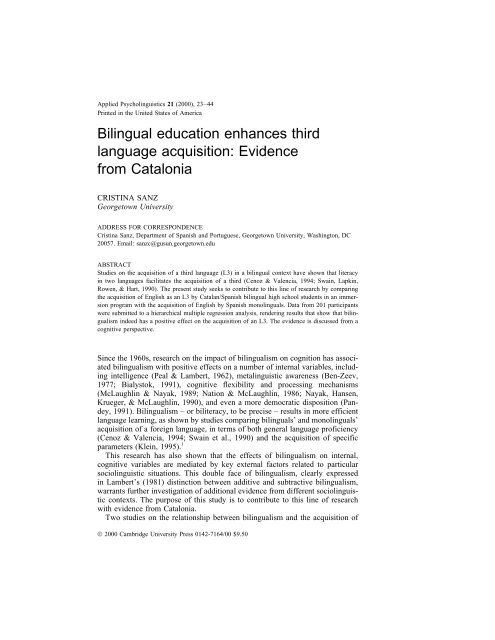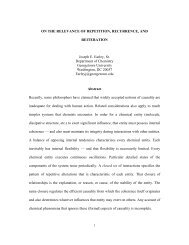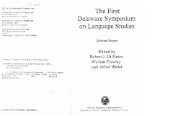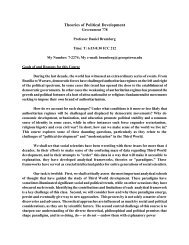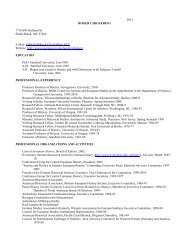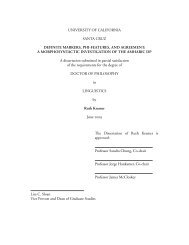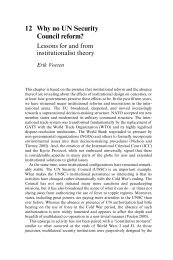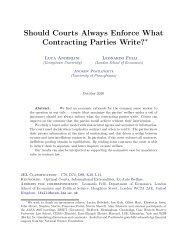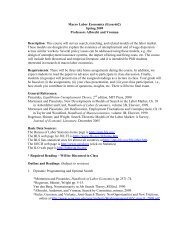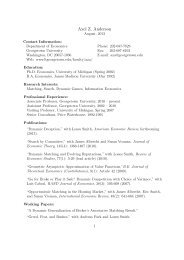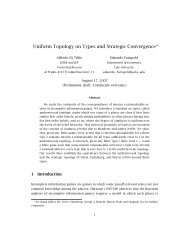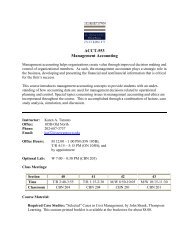Bilingual education enhances third language acquisition: Evidence ...
Bilingual education enhances third language acquisition: Evidence ...
Bilingual education enhances third language acquisition: Evidence ...
You also want an ePaper? Increase the reach of your titles
YUMPU automatically turns print PDFs into web optimized ePapers that Google loves.
Applied Psycholinguistics 21 (2000), 23–44<br />
Printed in the United States of America<br />
<strong>Bilingual</strong> <strong>education</strong> <strong>enhances</strong> <strong>third</strong><br />
<strong>language</strong> <strong>acquisition</strong>: <strong>Evidence</strong><br />
from Catalonia<br />
CRISTINA SANZ<br />
Georgetown University<br />
ADDRESS FOR CORRESPONDENCE<br />
Cristina Sanz, Department of Spanish and Portuguese, Georgetown University, Washington, DC<br />
20057. Email: sanzc@gusun.georgetown.edu<br />
ABSTRACT<br />
Studies on the <strong>acquisition</strong> of a <strong>third</strong> <strong>language</strong> (L3) in a bilingual context have shown that literacy<br />
in two <strong>language</strong>s facilitates the <strong>acquisition</strong> of a <strong>third</strong> (Cenoz & Valencia, 1994; Swain, Lapkin,<br />
Rowen, & Hart, 1990). The present study seeks to contribute to this line of research by comparing<br />
the <strong>acquisition</strong> of English as an L3 by Catalan/Spanish bilingual high school students in an immersion<br />
program with the <strong>acquisition</strong> of English by Spanish monolinguals. Data from 201 participants<br />
were submitted to a hierarchical multiple regression analysis, rendering results that show that bilingualism<br />
indeed has a positive effect on the <strong>acquisition</strong> of an L3. The evidence is discussed from a<br />
cognitive perspective.<br />
Since the 1960s, research on the impact of bilingualism on cognition has associated<br />
bilingualism with positive effects on a number of internal variables, including<br />
intelligence (Peal & Lambert, 1962), metalinguistic awareness (Ben-Zeev,<br />
1977; Bialystok, 1991), cognitive flexibility and processing mechanisms<br />
(McLaughlin & Nayak, 1989; Nation & McLaughlin, 1986; Nayak, Hansen,<br />
Krueger, & McLaughlin, 1990), and even a more democratic disposition (Pandey,<br />
1991). <strong>Bilingual</strong>ism – or biliteracy, to be precise – results in more efficient<br />
<strong>language</strong> learning, as shown by studies comparing bilinguals’ and monolinguals’<br />
<strong>acquisition</strong> of a foreign <strong>language</strong>, in terms of both general <strong>language</strong> proficiency<br />
(Cenoz & Valencia, 1994; Swain et al., 1990) and the <strong>acquisition</strong> of specific<br />
parameters (Klein, 1995). 1<br />
This research has also shown that the effects of bilingualism on internal,<br />
cognitive variables are mediated by key external factors related to particular<br />
sociolinguistic situations. This double face of bilingualism, clearly expressed<br />
in Lambert’s (1981) distinction between additive and subtractive bilingualism,<br />
warrants further investigation of additional evidence from different sociolinguistic<br />
contexts. The purpose of this study is to contribute to this line of research<br />
with evidence from Catalonia.<br />
Two studies on the relationship between bilingualism and the <strong>acquisition</strong> of<br />
© 2000 Cambridge University Press 0142-7164/00 $9.50
Applied Psycholinguistics 21:1 24<br />
Sanz: <strong>Bilingual</strong>ism and L3 <strong>acquisition</strong><br />
a <strong>third</strong> <strong>language</strong> (L3) have produced contradictory results. On the one hand,<br />
Wagner, Spratt, and Ezzaki (1989) concluded that L1 (Berber) illiteracy does<br />
not hinder L2 (Arabic) or L3 (French) literacy, based on their own evidence<br />
from Morocco. Therefore, the authors suggested that UNESCO’s recommendation<br />
to teach children to read in their L1 would be an unnecessary burden on<br />
countries like Morocco, which lacks a strong economic base and where a substantial<br />
portion of the population speaks a <strong>language</strong> without a writing system.<br />
On the other hand, Cenoz and Valencia (1994) found that in the Basque Country<br />
students in Basque immersion schools outperformed students in majority <strong>language</strong><br />
(Spanish) schools in their English proficiency test. Cenoz et al.’s results<br />
are in conformity with those of Swain et al. (1990), who investigated the impact<br />
of L1 literacy on L3 (French) proficiency in the Toronto metropolitan area.<br />
Results from the Basque and the Canadian studies disprove the general belief<br />
that literacy in the L1 interferes with or retards achieving control over the L2<br />
and L3 (Swain et al., 1990). Obviously, the positive evidence provided by two<br />
out of three studies does not allow for universal generalizations on the effects<br />
of bilingual <strong>education</strong> on L3 <strong>acquisition</strong>. 2<br />
There are many differences among these studies, which may account for their<br />
contradictory results. For one, there is the issue of methodology. Wagner et<br />
al.’s (1989) was a 6-year longitudinal study of primary school literacy in three<br />
<strong>language</strong>s. Both Swain et al.’s (1990) and Cenoz and Valencia’s (1994) designs<br />
were cross-sectional, focused on general linguistic ability (oral and written), and<br />
included older students as participants. A problem for bilingualism and applied<br />
linguistics scholars is their inability to formulate general conclusive statements<br />
because of the small number of studies; the variety of methods, samples, and<br />
variables used; and the lack of replication studies (Sanz, 1997a).<br />
A key distinction made in these three studies is that of bilingualism versus<br />
biliteracy. Wagner et al. (1989) compared bilinguals literate in the L2 with monolinguals,<br />
while Cenoz and Valencia (1994) compared bilinguals literate in both<br />
the L1 and L2 with monolinguals. None of the studies separated oral proficiency<br />
from written proficiency in two <strong>language</strong>s or bilingualism from biliteracy. In<br />
contrast, Swain et al.’s study isolated both variables by comparing biliterate<br />
bilinguals with bilinguals literate only in the L2. Based on their evidence, Swain<br />
et al. concluded that the key to the cognitive advantage reflected in more efficient<br />
L3 <strong>acquisition</strong> is biliteracy and not bilingualism. <strong>Bilingual</strong>s illiterate in<br />
their L1 did not perform significantly better than the monolingual group. In the<br />
present study, as in Cenoz and Valencia (1994), all participants in the bilingual<br />
sample were biliterate, while all monolingual participants, unlike those in that<br />
study, were true monolinguals who lived in a monolingual area. Cenoz and<br />
Valencia’s monolingual participants lived in a bilingual area and attended a<br />
school where Basque was taught for 4 hours a week. Any advantage found in<br />
favor of the bilingual group could be assumed to be the result of their “fully<br />
developed bilingualism”: that is, control over, and frequent use of, the four skills<br />
(reading, writing, speaking, and understanding) in both <strong>language</strong>s – the outcome<br />
of attending a bilingual program.<br />
Another variable that Swain et al. (1990) investigated is the typology of the<br />
three <strong>language</strong>s involved. They hypothesized that bilinguals whose L1 belonged
Applied Psycholinguistics 21:1 25<br />
Sanz: <strong>Bilingual</strong>ism and L3 <strong>acquisition</strong><br />
to the Romance family would benefit the most from their bilingual experience<br />
and the positive influence it would exert in the <strong>acquisition</strong> of the L3 (French,<br />
likewise a Romance <strong>language</strong>). The evidence confirmed the hypothesis. In the<br />
present study, like Cenoz and Valencia (1994) and Wagner et al. (1989), <strong>language</strong><br />
typology was not a variable under analysis. However, the three studies<br />
differed tremendously in the typology of the <strong>language</strong>s involved: Wagner et<br />
al.’s participants were native speakers of Berber learning Arabic as an L2 and<br />
French as an L3; Cenoz and Valencia’s participants were native speakers of<br />
Basque or Spanish in a Basque bilingual program with English as their L3. In<br />
these studies, the three <strong>language</strong>s belonged to different families. In light of<br />
Swain et al.’s research, the relationship among the <strong>language</strong>s involved might<br />
also account for differences in the results of research on the effects of bilingualism<br />
on L3 <strong>acquisition</strong>. In the present study, the participants were learning English<br />
as an L3, and both their L1 and L2 were Romance <strong>language</strong>s.<br />
As pointed out in Cenoz and Valencia (1994), probably the most important<br />
factor determining the results of the three studies is the type of sociolinguistic<br />
situation, which results in additive or subtractive linguistic consequences. According<br />
to Lambert (1981), when members of the majority group learn an L2 in order<br />
to become bilingual, bilingualism results in additive linguistic consequences.<br />
However, when members of the minority <strong>language</strong> group learn an L2 which might<br />
replace their native <strong>language</strong>, bilingualism results in subtractive linguistic consequences.<br />
Thus, bilingualism has a positive outcome depending on the status of the<br />
<strong>language</strong>s involved. In the rural areas of the Moroccan Atlas, the population is<br />
divided between native speakers of Arabic and those of Berber. Arabic is a written<br />
<strong>language</strong> that enjoys a long cultural tradition and international stature. It is the<br />
<strong>language</strong> of instruction in all Arab countries and is, moreover, the sacred <strong>language</strong><br />
of the Koran. Arabic enjoys a privileged status with respect to Berber, a minority<br />
<strong>language</strong> without a writing system. The situation in the Moroccan Atlas, where the<br />
Berber minority is instructed in Arabic, stands in stark contrast to the relationship<br />
described in Cenoz and Valencia’s study of bilingualism in the Basque Country,<br />
where speakers of the majority <strong>language</strong> (Spanish) attend immersion programs in<br />
the minority <strong>language</strong> (Basque).<br />
Since 1978, when Basque and Spanish were declared co-official by the Spanish<br />
constitution, progressive political autonomy has provided the Basque government<br />
with the tools to recover Basque from the 40 years of linguistic repression<br />
that followed the Spanish Civil War – repression that resulted in<br />
widespread use of Spanish in the area, making it the majority <strong>language</strong>. The<br />
Basque <strong>language</strong> is now spoken by 30% of the population, and Basque monolinguals,<br />
who could once be found in a few isolated rural areas, have disappeared.<br />
To ensure that all students graduate with some knowledge of both <strong>language</strong>s,<br />
three linguistic models (A, B, and D), incorporating both Spanish and Basque<br />
to different extents, were created. A fourth model (X), which does not incorporate<br />
Basque in any way, still remains. Model A has Spanish as the only <strong>language</strong><br />
of instruction; Basque is taught as an L2 for 4 hours a week. Model B combines<br />
both Basque and Spanish. Model D has Basque as the sole <strong>language</strong> of instruction;<br />
Spanish is taught for 4 hours a week (Artigal, 1993). 3 All three programs<br />
include 4 hours of a foreign <strong>language</strong>, English. In recent years, enrollments have
Applied Psycholinguistics 21:1 26<br />
Sanz: <strong>Bilingual</strong>ism and L3 <strong>acquisition</strong><br />
increased in those models that give prominence to Basque, although the numbers<br />
remain low, and the <strong>language</strong> is more valued and widely used, including by the<br />
media and government (Cenoz & Valencia, 1994).<br />
Cenoz’s dissertation study (1991), elaborated in Cenoz and Valencia (1994)<br />
and Cenoz (1996), compared the <strong>acquisition</strong> of English as a foreign <strong>language</strong><br />
by 320 high school seniors in majority (type A) and minority (type D) <strong>language</strong><br />
programs. A number of independent variables were grouped into four different<br />
types of factors: (a) cognitive (i.e., intelligence); (b) social/psychological (i.e.,<br />
attitudes toward the <strong>language</strong> community and motivation); (c) <strong>education</strong>al (i.e.,<br />
number of years of English study); and (d) sociostructural (gender and SES).<br />
Overall <strong>language</strong> proficiency was the dependent variable. In Cenoz and Valencia<br />
(1994), multiple regression analyses identified intelligence, age, motivation, exposure,<br />
and bilingualism as factors predicting English achievement, and the inclusion<br />
of bilingualism in the equation increased the percentage of variance<br />
explained. Given the lack of significant interactions, the researchers concluded<br />
that bilingualism predicts L3 achievement independently of all other factors.<br />
Unlike Berber children, who are illiterate in their L1, the students in immersion<br />
schools (type D schools) in the Basque country are likely to graduate with<br />
a balanced knowledge of Spanish and Basque and thus will benefit from their<br />
linguistic experience. Cummins’s (1976) threshold hypothesis links social and<br />
<strong>education</strong>al variables to cognitive ones. According to this hypothesis, learners<br />
must develop age-appropriate knowledge of the <strong>language</strong> in both the L1 and the<br />
L2 to enjoy cognitive abilities over monolinguals. Sociolinguistic contexts that<br />
promote additive bilingualism, like the one characterizing the Basque Country<br />
and its immersion program, create the social conditions necessary for the cognitive<br />
benefits of bilingualism to appear. An example of such an advantage is the<br />
more efficient <strong>acquisition</strong> of an L3 (Cenoz, 1991).<br />
Also within Spain, the population of Catalonia, a bilingual area where Spanish<br />
is the majority <strong>language</strong> sharing official status with Catalan, assumes the<br />
same positive effects. Results from a survey on attitudes toward bilingualism<br />
and bilingual <strong>education</strong> in Catalonia (Strubell & Romaní, 1986) showed that,<br />
given the choice between a monolingual and a bilingual school, both bilingual<br />
and monolingual respondents would choose a bilingual school for their children.<br />
One of the reasons interviewees provided for their choice was the belief that<br />
proficiency in Spanish and Catalan would help their children learn a foreign<br />
<strong>language</strong>. Multilingualism, and specifically knowledge of English, is highly valued<br />
in a region that proudly embraces its European identity and the benefits of<br />
its membership in the European Community. Is the population right to think<br />
that bilingual <strong>education</strong> pays not only double but triple dividends Can this<br />
“hunch” be confirmed<br />
It has been argued that bilingualism has a double face (i.e., societal and individual),<br />
and that individual bilingualism is determined in most cases by societal<br />
bilingualism. Thus, in the end, it is the social aspect of bilingualism, and especially<br />
the availability of bilingual <strong>education</strong>, that determines the development of<br />
cognitive benefits deriving from experience with two <strong>language</strong>s, including the<br />
benefits involved in the <strong>acquisition</strong> of an L3. Therefore, the Basque and the<br />
Catalan sociolinguistic situations are similar enough to expect comparable ef-
Applied Psycholinguistics 21:1 27<br />
Sanz: <strong>Bilingual</strong>ism and L3 <strong>acquisition</strong><br />
Table 1. Evolution of knowledge of Basque between 1986 and 1996<br />
Knowledge of Basque 1986 (%) 1991 (%) 1996 (%)<br />
Euskaldun a 24.6 26.3 30.9<br />
Biliterate 15.3 17.8 23.5<br />
Partially biliterate 6.6 6.1 5.5<br />
Illiterate 2.7 2.3 1.9<br />
Quasi Euskaldun b 17.4 19.8 19.7<br />
Literate 10.6 17.8 12.9<br />
Partially literate 3.7 3.5 3.2<br />
Illiterate 3.1 3.6 3.6<br />
Erdaldun c 58.4 53.9 49.4<br />
Total Population 2,089,995 2,068,927 2,062,525<br />
Note: From the Basque Government Statistics Office’s Web page,<br />
http://www.eustat.es.<br />
a Euskaldun: “Understands and speaks Basque well”; related to the root<br />
eusk- ‘Basque’.<br />
b Quasi Euskaldun: “Has problems understanding and/or speaking<br />
Basque.”<br />
c Erdaldun: “Does not understand or speak Basque”; related to the root<br />
erda- ‘foreigner’.<br />
fects of schooling in the minority <strong>language</strong> on L3 <strong>acquisition</strong>. However, differences<br />
in linguistic genealogy, social use of the <strong>language</strong>s involved, and methodological<br />
issues justify further research.<br />
While Catalan and Spanish are both Romance <strong>language</strong>s, Basque does not<br />
share a common origin with Spanish. Research by Swain et al. (1990) showed<br />
that <strong>language</strong> genealogy is a key variable in L3 research. In addition, Catalan<br />
enjoys a higher level of knowledge and broader use than does Basque with<br />
respect to Spanish – in part due to the lack of genetic relationship between<br />
Spanish and Basque – which makes Basque, compared to Catalan, much more<br />
difficult to learn for immigrants from other monolingual areas in Spain. In addition,<br />
Catalan nationalism defines its identity on the singularity of its culture, of<br />
which the Catalan <strong>language</strong> is the quintessential expression. Basque nationalism<br />
has preferred other signs of identity, such as race and religion, and has at times<br />
paid little or no attention to the <strong>language</strong> (Conversi, 1997). Despite long periods<br />
of linguistic repression, which erased Catalan from formal contexts such as the<br />
media and <strong>education</strong>, Catalan has always enjoyed high status because of its<br />
traditional association with the powerful industrial upper bourgeoisie. Basque<br />
has commonly been associated with speakers from rural areas. 4 Finally, Catalan<br />
was introduced in public <strong>education</strong> much earlier than Basque, which still relies<br />
on a well organized system of Basque private schools, the ikastolas. Table 1<br />
summarizes information on knowledge of Basque among the population of the<br />
Basque Country. It is necessary to clarify that the distribution of Basque speakers<br />
in the three provinces 5 that make up the Basque Country is irregular: 49.7%<br />
in Gipuzkoa, 23.7% in Bizkaya, and only 14.6% in Araba. 6
Applied Psycholinguistics 21:1 28<br />
Sanz: <strong>Bilingual</strong>ism and L3 <strong>acquisition</strong><br />
Table 2. Evolution of Catalan proficiency in Catalonia<br />
between 1986 and 1991<br />
Skill 1986 (%) 1991 (%)<br />
Understands 90.60 93.80<br />
Speaks 64.20 68.30<br />
Reads 60.70 67.60<br />
Writes 31. 39.90<br />
Total Population 5,856,435 5,949,177<br />
Note: From the Catalan Government Web page, http://<br />
cultura.gencat.es.<br />
The goal of the present study was to investigate the relationship between<br />
biliteracy in the minority and majority <strong>language</strong>s and the <strong>acquisition</strong> of English<br />
as a foreign <strong>language</strong>. This was done by comparing the English proficiency of<br />
high school juniors attending a monolingual school in a monolingual area of<br />
Spain with their peers in a bilingual school of similar characteristics in a Catalan<br />
bilingual area. Specifically, the study isolated a number of independent variables,<br />
including bilingualism, that could contribute to the <strong>acquisition</strong> of an L3<br />
in order to answer the following research questions: Does Catalan/Spanish biliterate<br />
bilingualism contribute to more efficient <strong>acquisition</strong> of English as an L3<br />
Is that contribution independent from that of other predicting factors, such as<br />
intelligence, motivation, or sociolinguistic status<br />
THE STUDY<br />
Sociolinguistic background<br />
Catalan, a Romance <strong>language</strong>, has shared co-officiality with Spanish since 1976.<br />
In Catalonia, although the presence of Catalan is growing every day, Spanish is<br />
still widely used, especially in the capital of Barcelona, as a consequence of<br />
almost 40 years of repression and waves of immigrants from monolingual regions<br />
of Spain during the second half of this century. This last phenomenon<br />
significantly changed the linguistic composition of Catalonia: the percentage of<br />
Catalan speakers decreased from 75% in 1940 to only 60% in 1975. The assimilation<br />
of these immigrants was not encouraged; on the contrary, migration took<br />
place at a time when Catalan was strictly banned from the public arena. Catalan<br />
speakers became accustomed to addressing strangers in Spanish and to using<br />
Spanish in formal contexts like the workplace.<br />
In the early 1980s, the Catalan autonomous government created the General<br />
Secretariat for Linguistic Policy, which implemented the Catalan Normalization<br />
Law (passed by the Catalan Parliament) in an attempt to change the sociolinguistic<br />
situation by strengthening the presence of Catalan in the public domain.<br />
Three fronts were identified: linguistic awareness, the media, and <strong>education</strong>.<br />
Catalan was declared by law the llengua vehicular ‘<strong>language</strong> of instruction’ in<br />
all Catalan schools. Table 2 summarizes data from the 1986 and 1991 censuses
Applied Psycholinguistics 21:1 29<br />
Sanz: <strong>Bilingual</strong>ism and L3 <strong>acquisition</strong><br />
Table 3. Catalan proficiency in Catalonia based on the 1996 census<br />
Understands Speaks Reads Writes<br />
Population (%) (%) (%) (%)<br />
2–14 year olds 97.00 83.50 70.60 59.30<br />
15–29 year olds 98.30 90.40 90.20 78.70<br />
30–44 year olds 96.80 74.90 76.20 41.60<br />
45–59 year olds 94.30 63.60 63.00 25.50<br />
60–74 year olds 90.30 63.10 58.40 22.50<br />
75–84 year olds 85.80 65.40 56.60 23.30<br />
85 and older 83.90 66.60 52.40 20.30<br />
Note: Population total: 5,984,000. From the Institut d’Estadística de Catalunya<br />
Web page, http://www.idescat.es.<br />
on knowledge of Catalan, and Table 3 presents similar data from the latest<br />
census (1996). In Table 3, percentages are arranged by age group; two groups<br />
appear in boldface so that they may be compared more easily. The differences<br />
in Catalan <strong>language</strong> literacy between the groups attest to the success of the<br />
measures taken by the Catalan institutions.<br />
In 1980, there were a number of private schools with a Catalan curriculum<br />
already in place. The data for this study come from one such school. In 1990,<br />
40% of all students attended schools where Catalan was the <strong>language</strong> of instruction.<br />
By the late 1980s, Catalan immersion programs were implemented in<br />
schools in the Barcelona metropolitan area, where immigrants tend to settle in<br />
Spanish-speaking neighborhoods. Although the presence of Catalan was still<br />
less important in private than in public schools, the number of schools with<br />
Catalan as the <strong>language</strong> of instruction increased slowly but surely. Beginning<br />
with the graduating class of 1992, all high school graduates in Catalonia graduated<br />
with <strong>language</strong> skills in Catalan that would allow them to conduct administrative<br />
and <strong>education</strong>al tasks in both Catalan and Spanish. Today, a goal of the<br />
<strong>education</strong>al system is to provide students with equal proficiency in both <strong>language</strong>s.<br />
Spanish, the majority <strong>language</strong>, and its literature are taught in Spanish<br />
for 8 hours a week. English is taught for 4 hours per week.<br />
METHOD<br />
Participants<br />
Well over 200 individuals participated in the study, but only the 201 students<br />
(77 monolinguals and 124 bilinguals) who completed all tests and questionnaires<br />
formed the final sample. The participants were male (62%) and female (38%)<br />
high school juniors from two private schools situated in urban areas of northern<br />
Spain. Both are Jesuit schools; consequently, they share not only many important<br />
characteristics imposed by government-generated standards and regulations,<br />
but also a common approach to <strong>education</strong> and goals characteristic of all Jesuit<br />
schools. They serve a similar population and implement similar rules in areas
Applied Psycholinguistics 21:1 30<br />
Sanz: <strong>Bilingual</strong>ism and L3 <strong>acquisition</strong><br />
such as student failure, consequently imposing limitations on the range of SES<br />
and age values. The main difference between the two schools lies in the <strong>language</strong><br />
of instruction (i.e., Catalan vs. Spanish).<br />
Answers to the questionnaire completed by all bilingual participants (see Appendix)<br />
confirmed that they used both Catalan and Spanish on a daily basis in<br />
and out of school and for activities as varied as shopping, watching TV, practicing<br />
sports, and taking notes. Almost 50% of the participants were born in bilingual<br />
homes, where one parent spoke Catalan and the other spoke Spanish. As high<br />
school juniors, they were preparing for the state exam that grants access to college.<br />
The exam requires academic written ability in both Spanish and Catalan. The<br />
monolingual participants lived in a monolingual area and therefore were exposed<br />
to only one <strong>language</strong>. Participants from multilingual households (with <strong>language</strong>s<br />
other than Spanish or Catalan) were eliminated from the final sample.<br />
Materials and scoring procedures<br />
The participants completed a release form, and all tests and questionnaires were<br />
completed in two 50-minute sessions in their own classrooms in May of 1996.<br />
During the first session, the participants signed the release form, answered the<br />
questionnaire, and completed one section of the Raven’s Progressive Matrices<br />
Test (Foulds & Raven, 1950) rather than the full version (due to time constraints).<br />
During the second session, the participants completed the vocabulary<br />
and structure sections of the CELT English proficiency test (Harris & Palmer,<br />
1970). Both sections followed a multiple choice format, and each included 75<br />
items. The participants also completed a questionnaire (presented in its full version<br />
in the Appendix), which was divided into the following parts.<br />
1. Personal information included age, gender, and SES. 7 The questionnaire<br />
asked for approximate income and profession of both parents. Each parent was<br />
then assigned into a category where 1 stood for working class; 2, middle class;<br />
and 3, upper middle class (based on Cenoz, 1991). By combining both parents<br />
in each household, five different categories were obtained: 2 through 6. Previous<br />
research has based SES solely on the father’s data. In urban areas of Spain,<br />
however, a significant percentage of women work and contribute to household<br />
income. A majority (65%) of the households belonged to category 2; 20%, category<br />
3; 38%, category 4; 21%, category 5; and 14%, category 6.<br />
2. Intelligence was measured via the Raven’s Progressive Matrices Test.<br />
3. Exposure to English included the number of English courses and the<br />
hours per course at school as well as in after school programs and in summer<br />
programs in Spain and abroad. The score was calculated by adding the number<br />
of hours of English instruction at school, in after school programs and tutoring,<br />
and in summer programs in Spain or abroad. Special attention was paid to eliciting<br />
detailed information on informal exposure to English (e.g., music, television,<br />
pen pals, etc.), which was scored by adding the number of items mentioned. For<br />
example, participant A commented that she listened to music in English and<br />
watched CNN, for which she was given a score of 2; participant B said he had<br />
an American pen pal, watched MTV, and read graded readings, for which he<br />
was given a score of 3. Formal and informal exposure were introduced as separate<br />
independent variables in the analysis. 8
Applied Psycholinguistics 21:1 31<br />
Sanz: <strong>Bilingual</strong>ism and L3 <strong>acquisition</strong><br />
4. Motivation to learn English was measured by means of a Likert-format<br />
questionnaire (adapted from Gardner, 1985, and Cenoz, 1991). This questionnaire<br />
included ten statements to which the participant reacted by choosing<br />
among the following: totally agree, agree, no opinion, disagree, totally disagree.<br />
The questionnaire included positive and negative statements, such as “I will use<br />
English after graduation” or “Learning English is difficult.” A score was calculated<br />
for each participant by adding the scores from the ten items in the questionnaire.<br />
Raw scores were used in the analyses.<br />
5. Attitudes toward the British and U.S. population and their varieties of<br />
English were elicited by means of a questionnaire that followed Osgood’s semantic<br />
differentials format. It consisted of five pairs of antonyms that were<br />
applied to each population group (variables 8 and 9). Two other antonyms were<br />
applied to the two linguistic varieties (variables 10 and 11). The adjectives chosen<br />
were used successfully in Sanz (1992), a study with a similar population,<br />
and were presented following this example: “What do you think people in the<br />
United States are like” “cultivated<br />
ignorant.” The participants<br />
were expected to choose one among the five spaces provided. For this variable,<br />
the score for each participant was calculated by adding the scores from the five<br />
semantic differential items on the questionnaire. 9<br />
This part of the questionnaire was administered in Spanish. The bilingual<br />
group completed a second part of the questionnaire (administered in Catalan),<br />
which included numerous items that elicited their knowledge and use of both<br />
<strong>language</strong>s. The monolingual group was addressed in Spanish, and the bilingual<br />
group was addressed in Catalan. The participants were informed that the study<br />
included groups from different areas in Spain. Data were coded, a database was<br />
created implementing a form generated with Microsoft Access ® , and the data<br />
were then transferred to SAS (SAS Institute Inc., 1996), with which all analyses<br />
were performed.<br />
Analysis<br />
Following Cenoz and Valencia (1994), a hierarchical multiple regression analysis<br />
was applied to assess the relationship between biliterate bilingualism and the<br />
<strong>acquisition</strong> of English as a foreign <strong>language</strong>. The dependent variable was English<br />
proficiency, calculated as the sum of the scores from the vocabulary and<br />
structure tests. Table 4 summarizes the means and standard deviations for all<br />
variables.<br />
RESULTS<br />
The goal of the present study was to contribute Catalan data to the body of<br />
research on the interface between bilingualism and L3 <strong>acquisition</strong>. Specifically,<br />
it attempted to isolate the effects of additive bilingualism on proficiency in<br />
English as a foreign <strong>language</strong> by partialing out the effects of all other factors.<br />
To achieve this goal, a sequence of regression analyses, including a hierarchical<br />
regression analysis, was performed following a series of steps. Step one consisted<br />
of a regression analysis to identify the factors associated with higher
Applied Psycholinguistics 21:1 32<br />
Sanz: <strong>Bilingual</strong>ism and L3 <strong>acquisition</strong><br />
Table 4. Means and standard deviations for all variables<br />
Variable Mean SD Min. Max.<br />
Intelligence 10.71 1.25 0 12<br />
Age 16.53 .59 16 18<br />
SES 4.17 1.11 2 6<br />
Motivation 4.59 5.34 −14 18<br />
Attitudes toward U.K. 1.47 3.89 −12 10<br />
Attitudes toward U.S. .40 3.67 −12 9<br />
Attitudes toward U.K. <strong>language</strong> .42 2.05 −4 4<br />
Attitudes toward U.S. <strong>language</strong> .12 1.88 −4 4<br />
Exposure 1026.6 355.76 156 2376<br />
Informal exposure 1.72 1.0 0 5<br />
Achievement (bilinguals) 46.169 9.058 23 66<br />
Achievement (monolinguals) 40.18 8.444 22 62<br />
Note: N = 201.<br />
Table 5. Multiple regression of all variables on<br />
English achievement<br />
Parameter<br />
Variable estimate T r 2<br />
IQ .613 .191<br />
Gender .173 .890<br />
Age −.106 .916<br />
Father SES −.507 .544<br />
Mother SES 1.483 .052<br />
British .075 .568<br />
American −.020 .880<br />
Motivation .756 .000**<br />
Exposure .003 .043*<br />
Informal exposure .670 .300<br />
.26<br />
*p < .05; **p < .01.<br />
performance on the English test. As shown in Table 5, which presents the results<br />
of this first analysis, only two predictors – exposure and motivation – significantly<br />
contributed to <strong>language</strong> achievement. In both cases the relation was positive,<br />
since high scores on exposure and motivation were associated with high<br />
scores on the English tests. The overall regression effect was significant, F =<br />
8.5, p < .0001, r 2 = .26.<br />
The second step consisted of performing a hierarchical multiple regression<br />
analysis, first to partial out the effects from the two predicting factors identified<br />
and then to observe the effects of bilingualism on L3 <strong>acquisition</strong>. This was done<br />
to avoid multicolinearity, since the variables could be intercorrelated (Cenoz &
Applied Psycholinguistics 21:1 33<br />
Sanz: <strong>Bilingual</strong>ism and L3 <strong>acquisition</strong><br />
Table 6. Multiple regression of motivation, exposure, and<br />
bilingualism on English achievement<br />
Variable Parameter estimate r 2 F value<br />
Motivation .809<br />
Exposure .003<br />
.24 35.067**<br />
<strong>Bilingual</strong>ism 5.310 .33 32.611**<br />
**p < .01.<br />
Table 7. Multiple regression of motivation, exposure, and<br />
bilingualism on English achievement and interactions<br />
Parameter<br />
Variable estimate r 2 F value<br />
Motivation .858 .244 64.251**<br />
<strong>Bilingual</strong>ism 4.337 .294 41.241**<br />
Motivation/<strong>Bilingual</strong>ism .276 .30 .1918<br />
Exposure .006 .054 11.394**<br />
<strong>Bilingual</strong>ism 7.156 .189 23.199**<br />
Exposure/<strong>Bilingual</strong>ism .000 .189 15.388<br />
**p < .001.<br />
Valencia, 1994). In this part of the analysis, the key factors were motivation,<br />
exposure, and bilingualism. All the other factors were not introduced in the<br />
analyses as they had proven not to be significant predictors (p > .05).<br />
First, motivation and exposure were introduced to observe the overall regression<br />
effect, which was significant, F = 35.06, p < .0001, r 2 = .24. Then, bilingualism<br />
was introduced, resulting in greater predictive power, F = 32.61, p <<br />
.0001, r 2 = .33. Table 6 summarizes the results. Third, two sets of multiple regressions<br />
were carried out to identify any possible significant relationship between<br />
bilingualism and the two predicting factors identified in step one. It was<br />
important to be certain that the effects of bilingualism were totally independent<br />
of the effects of the other two factors. Motivation and exposure were entered<br />
first in the analysis, followed by bilingualism and finally by the interaction<br />
between motivation and exposure and bilingualism. Table 7 summarizes the<br />
results, which show significant levels for both factors as well as how the addition<br />
of bilingualism significantly increases the percentage of variance (explained<br />
by 5% in the case of motivation and by 13% in the case of exposure). The<br />
results from this last set of analyses also show no significant interaction between<br />
the factors and bilingualism, which means that bilingualism is associated with<br />
higher performance in the achievement test independently from other factors.<br />
These results replicate those of Cenoz and Valencia (1994). As in the case of<br />
the Basque immersion program, students in the Catalan immersion program
Applied Psycholinguistics 21:1 34<br />
Sanz: <strong>Bilingual</strong>ism and L3 <strong>acquisition</strong><br />
showed an advantage as L3 learners compared with students in a monolingual<br />
school. Catalan bilingualism, like Basque bilingualism, explains superior English<br />
achievement independently from other variables. Another commonality between<br />
Cenoz and Valencia’s results and those presented here is the significant role that<br />
both motivation and exposure play as factors predicting L3 proficiency. In contrast<br />
with data from the Basque Country, however, L3 proficiency does not appear to<br />
be related to age or intelligence. Methodological reasons account for these differences.<br />
The sample in Cenoz (1991) was made up of students in private and public<br />
schools, where students who are not promoted can stay in school for a maximum<br />
total of three extra years, which explains the wide range of ages of students in the<br />
same class. In private schools in general and in Jesuit schools in particular, such<br />
a practice is rare, thus reducing age variation. In the present sample, ages ranged<br />
between 16 and 17, except for three 18-year-old students.<br />
As for intelligence, another factor expected to predict L3 achievement, limitations<br />
in the testing procedure were responsible for a lack of significant results.<br />
The reader may recall that only one part of the Raven’s Progressive Matrices<br />
Test was administered due to the limited contact time available with the participants.<br />
Sections have twelve items, and all participants scored within the 8 to 12<br />
range. As in the case of age, the intelligence factor was not significant due to<br />
the small amount of variation allowed by the narrow range of scores.<br />
To sum up, despite different sociolinguistic contexts, different measurements,<br />
higher control over <strong>language</strong> exposure in the monolingual sample, and the different<br />
genealogies of the <strong>language</strong>s involved, results from the present study<br />
replicate those from Cenoz and Valencia (1994), showing that immersion programs<br />
in the minority <strong>language</strong>, whether in the Basque Country or in Catalonia,<br />
produce more efficient L3 learners.<br />
DISCUSSION<br />
The goal of this article was to evaluate the impact of bilingualism on L3 proficiency.<br />
<strong>Evidence</strong> is provided in favor of a positive relationship between Catalan/<br />
Spanish biliterate bilingualism and knowledge of English as a foreign <strong>language</strong>,<br />
thus adding to the evidence contributed by Swain et al. (1990) from Englishspeaking<br />
Canada and by Cenoz and Valencia (1994) from the Basque Country.<br />
These studies show that L1 and L2 literacy has a positive effect on L3 learning;<br />
the next step is to explain these effects. Two questions come to mind. What<br />
aspect of <strong>language</strong> <strong>acquisition</strong> is positively affected Why is it affected Although<br />
the study reported here does not operationalize factors, such as enhanced<br />
working memory or metalinguistic awareness, that could explain the advantage<br />
of bilinguals over monolinguals on L3 <strong>acquisition</strong>, it is still possible to offer<br />
some hypotheses.<br />
Research suggests three aspects of the <strong>acquisition</strong> of nonprimary <strong>language</strong>s that<br />
need to be considered: route or <strong>acquisition</strong>al stages, rate, and final attainment.<br />
Route seems impervious to external or internal influences, including age, context<br />
of <strong>acquisition</strong>, and <strong>language</strong> typology. However, rate and final attainment vary to<br />
a great extent (Larsen-Freeman & Long, 1991). Therefore, it can be hypothesized<br />
that bilinguals will be more efficient <strong>language</strong> learners, since they will learn an
Applied Psycholinguistics 21:1 35<br />
Sanz: <strong>Bilingual</strong>ism and L3 <strong>acquisition</strong><br />
L3 faster and will reach a higher level of attainment than monolinguals. It can be<br />
further hypothesized that both bilinguals and monolinguals will follow the same<br />
<strong>acquisition</strong>al route. A study by Klein (1995) tested these hypotheses.<br />
Klein (1995) was interested in investigating the effects of prior linguistic<br />
experience on the <strong>acquisition</strong> of preposition stranding by a group of 17 monolingual<br />
immigrants and 15 multilingual immigrants learning English as an L2. Her<br />
results showed that both groups of learners produced the same type of errors,<br />
which she interpreted as evidence that the route leading to <strong>acquisition</strong> of the<br />
parameter was the same. However, the rate at which both groups acquired the<br />
parameter was significantly different, with multilinguals resetting the parameter<br />
earlier than monolinguals. Klein differentiated between the <strong>acquisition</strong> of the<br />
syntactic structure, on the one hand, and the <strong>acquisition</strong> of the lexical items<br />
related to it (the specific verbs and prepositions), on the other. She observed<br />
that the multilingual group learned a higher number of the lexical items responsible<br />
for triggering parameter resetting. Klein interpreted these results as a consequence<br />
of enhanced cognitive skill on the part of multilinguals, which helped<br />
them pay closer attention to potential triggering data in the input.<br />
Within a cognitive approach to <strong>language</strong> <strong>acquisition</strong>, the learner is seen as a<br />
limited capacity processor. To understand and react to new information, the<br />
learner uses controlled processes that make heavy requirements on attention and<br />
consequently demand cognitive effort and time. Automatic processes are fast and<br />
efficient. Learning is seen as the automatization of processes as a result of experience.<br />
In a series of empirical studies (McLaughlin & Nayak, 1989; Nation &<br />
McLaughlin, 1986; Nayak et al., 1990), McLaughlin and his associates suggested<br />
that <strong>language</strong> learning experience contributes to the automatization of basic subskills<br />
involved in input processing and frees up resources that can then be devoted<br />
to focus on form. This is related to Klein’s (1995) reference to bilinguals’ enhanced<br />
cognitive skill. From the perspective of McLaughlin and his associates,<br />
Klein’s multilingual participants had resources available to focus on key items in<br />
the input. Because input is a requirement for <strong>language</strong> <strong>acquisition</strong>, input processing<br />
heavily influences <strong>language</strong> learning. Any advantage at this point is critical to<br />
explaining why bilinguals are more efficient <strong>language</strong> learners.<br />
Based on general cognitive principles, VanPatten (1996) elaborated a series of<br />
principles that are relevant for the present discussion. Given learners’ cognitive<br />
limitations, meaning and form compete for attention. According to the first principle,<br />
learners process input for meaning before they process it for form. According<br />
to the second principle, processing forms of low communicative value<br />
happens only after processing input for comprehension has been automatized,<br />
leaving space in working memory – the space where input is stored and processed<br />
in real time (Harrington & Sawyer, 1990). Therefore, working memory<br />
space is shared by two different functions. The more space is occupied by processing,<br />
the less space there is for storage. Automatic processes do not require<br />
as much space as controlled processes, and so they free up space for storage<br />
and processing, thereby increasing the amount of intake (i.e., processed linguistic<br />
data) available for integration into the learner’s system. It is unclear whether<br />
working memory is stable or whether it can be developed by factors such as<br />
enhanced exposure to input; the question of whether bilinguals have access to one
Applied Psycholinguistics 21:1 36<br />
Sanz: <strong>Bilingual</strong>ism and L3 <strong>acquisition</strong><br />
or two working memories 10 is also under discussion. Three empirical studies have<br />
established a relationship between working memory and the <strong>acquisition</strong> of nonprimary<br />
<strong>language</strong>s (Geva & Ryan, 1993; Harrington, 1991, 1992; Harrington & Sawyer,<br />
1990), but the direction of the causal relationship is still unknown. Nation and<br />
McLaughlin’s (1986) study on the <strong>acquisition</strong> of a miniature artificial <strong>language</strong> by<br />
novices (monolingual participants) and experts (multilingual participants) offers<br />
indirect evidence indicating that the direction originates in prior linguistic experience,<br />
which facilitates the automatization of <strong>language</strong> processing. 11<br />
Finally, other factors may contribute to this edge in <strong>language</strong> processing for<br />
<strong>acquisition</strong>. One of them, metalinguistic awareness (or explicit knowledge of<br />
the <strong>language</strong>), is one of the best-documented differences between bilinguals and<br />
monolinguals. Research by Bialystok (1986, 1987, 1991), Diaz (1985), Galambos<br />
and Goldin-Meadow (1990), Yelland, Pollard, and Mercury (1993), and<br />
Ricciardelli (1992a, 1992b) found bilinguals to have greater explicit knowledge<br />
of the <strong>language</strong>. The weak interface position in L2 <strong>acquisition</strong> theory (Ellis,<br />
1994) proposes that, while explicit knowledge cannot be transformed into implicit<br />
knowledge of the L2, it can help in the <strong>acquisition</strong> process by acting as<br />
an advanced organizer, focusing learners’ attention on the relevant features of<br />
the <strong>language</strong>. 12 That is, heightened metalinguistic awareness, which results from<br />
exposure to literacy in two <strong>language</strong>s, gives bilinguals the capacity to focus on<br />
form and pay attention to the relevant features in the input. Just as more efficient<br />
use of memory space <strong>enhances</strong> the amount of input that can be processed into<br />
intake, metalinguistic awareness <strong>enhances</strong> the quality of the intake that feeds<br />
into the inter<strong>language</strong> system. <strong>Bilingual</strong>s may naturally show the behavior that<br />
different researchers working within the focus on form tradition (Doughty &<br />
Williams, 1998) are trying to induce in classroom <strong>language</strong> learners.<br />
LIMITATIONS AND FUTURE RESEARCH<br />
A limitation present in the design of this study originates in the test administered<br />
to evaluate the participants’ proficiency in English. As a consequence of the short<br />
period of contact time allowed (data gathering took place one week before final<br />
examinations), the test included only a structure section and a vocabulary section.<br />
Therefore, and in contrast with Cenoz and Valencia (1994) and with Swain et al.<br />
(1990), I cannot make claims about the participants’ reading and oral skills. However,<br />
in light of Cenoz’s (1996) chapter, in which she investigated every skill<br />
component separately and found that participants in the immersion group outperformed<br />
those in the monolingual group on every skill except reading, I would not<br />
expect important findings. Other measurements implemented in this study need to<br />
be refined and better administered to avoid ceiling effects.<br />
The question of reliable, precise measurements is also of importance if future<br />
research is to locate an explanation for the positive relationship between bilingualism<br />
and L3 <strong>acquisition</strong>. For example, research is needed on the effects of<br />
prior linguistic experience on awareness. Studies such as Klein’s (1995), as well<br />
as the present article, have argued that heightened awareness at the level of<br />
noticing gives experienced <strong>language</strong> learners the edge. Evidently, experimental<br />
studies that include think aloud protocols in their design and compare bilinguals
Applied Psycholinguistics 21:1 37<br />
Sanz: <strong>Bilingual</strong>ism and L3 <strong>acquisition</strong><br />
and monolinguals while processing input are necessary if we are to claim that<br />
the groups differ in their processing strategies and basically their point of departure<br />
(Leow, 1997).<br />
A limitation inherent to observational research of the variety exemplified by<br />
this study is the possible bias that comes with sampling. In a true experimental<br />
study, participants are randomly assigned to each experimental group. In research<br />
that compares bilinguals and monolinguals, as in research on the effects<br />
of smoking on men and women, for example, randomization is impossible. One<br />
solution, suggested by Hakuta (1986) and applied in Hakuta and Diaz (1984),<br />
is to focus on the bilingual sample and to look at those factors that predict<br />
cognitive advantages. Sanz (in progress) is one such study. It centers around<br />
general factors identified in the literature on the <strong>acquisition</strong> of nonprimary <strong>language</strong>s<br />
(Ellis, 1994; Skehan, 1998), such as age of <strong>acquisition</strong> of the L2 and<br />
knowledge of both <strong>language</strong>s (i.e., balance).<br />
While all normal children have completed L1 <strong>acquisition</strong> by age 5, L2 learners<br />
start and complete <strong>acquisition</strong> of the L2 at different ages. The role of age in<br />
L2 <strong>acquisition</strong> is a critical issue, both for practical (i.e., when to introduce the<br />
L2 in the school curriculum) and theoretical reasons related to access to universal<br />
grammar, including the type of access (full, partial, or no access at all) after<br />
a certain age and the age itself. There is evidence suggesting that the age at<br />
which the L2 is acquired affects rate of <strong>acquisition</strong> and final success in that<br />
<strong>language</strong>. However, Sanz (in progress) investigated the relationship between the<br />
age at which the L2 was acquired and success in the <strong>acquisition</strong> of the L3. The<br />
hypothesis that earlier bilinguals (i.e., simultaneous bilinguals and those who<br />
have acquired the L2 before age 6) have benefited from extended practice with<br />
two <strong>language</strong>s and therefore show greater ability in learning the L3 could not<br />
be confirmed. The need to examine L3 <strong>acquisition</strong> in bilingual contexts from<br />
multiple perspectives is determined by the number of variables involved and<br />
their multiple interactions, making L3 <strong>acquisition</strong> a highly complex phenomenon.<br />
13 The issue of the role of age in <strong>language</strong> <strong>acquisition</strong> is a good example.<br />
The balance issue began with Peal and Lambert (1962), who, after an extensive<br />
review of all previous literature, concluded that only true bilinguals could<br />
be compared with monolinguals. In their 1962 study, they included only balanced<br />
bilinguals and found that they were superior to monolinguals in different<br />
measurements, including nonverbal intelligence and some types of verbal intelligence.<br />
However, a substantial number of subsequent studies yielded contradictory<br />
results on the cognitive advantages (and disadvantages) of bilingualism,<br />
which needed to be explained. Cummins’ threshold hypothesis (1976) is an<br />
attempt to do just that.<br />
Cummins did not claim that only balanced bilinguals benefit from the bilingual<br />
experience, but that an upper threshold must be reached to observe cognitive<br />
benefits. Cummins defined the upper threshold as “age appropriate skills in<br />
both <strong>language</strong>s.” The threshold hypothesis is a working hypothesis that needs<br />
to be developed. For example, the concept of “age appropriate skills” is not<br />
specific enough. Sanz (in progress) divided participants into three groups, from<br />
least to most balanced, based on their reported control over both oral and written<br />
skills. It was hypothesized that the control over both <strong>language</strong>s would make a
Applied Psycholinguistics 21:1 38<br />
Sanz: <strong>Bilingual</strong>ism and L3 <strong>acquisition</strong><br />
difference in their ability to learn an L3. The regression analysis showed that,<br />
while balance in the participants’ ability to listen and understand in Spanish and<br />
Catalan did not predict higher L3 scores, balance of the written skills is a significant<br />
predictor of L3 scores. Specifically, it is the English scores from the group<br />
with the highest balance that significantly contrast with the other two groups.<br />
These results, like those from Swain et al. (1990), show biliteracy rather than<br />
“oral bilingualism” to be the factor determining cognitive advantages.<br />
The goal of immersion programs is to produce fully biliterate bilinguals with<br />
a superior level of control over both <strong>language</strong>s and who frequently use both<br />
<strong>language</strong>s as required by the sociolinguistic situation that surrounds them. As<br />
shown by the present study, one of the outcomes of immersion programs is<br />
more efficient <strong>language</strong> learners.<br />
CONCLUSION<br />
One of the attractions of research on L3 <strong>acquisition</strong> in bilingual contexts is the<br />
possibility of studying <strong>language</strong> <strong>acquisition</strong> from multiple perspectives. This<br />
study demonstrates the importance of viewing bilingualism as both a social and<br />
an individual phenomenon. The relationship between bilingualism and cognitive<br />
development and its positive contribution to L3 learning processes is intrinsically<br />
linked to the particular social context in which the research is conducted.<br />
Specifically, this study confirms Cenoz and Valencia (1994) and Swain et al.<br />
(1990) research conducted in developed areas but counters Wagner et al. (1989)<br />
research in the Moroccan Atlas. Therefore, further research is needed on the<br />
impact of bilingualism on L3 <strong>acquisition</strong> in different bilingual communities. But<br />
this research must be psycholinguistic in nature and must understand and describe<br />
in detail the specifics of the sociolinguistic situation, including the status<br />
of the <strong>language</strong>s involved and the issues related to biliteracy. Identification of a<br />
positive effect of bilingual programs on L3 <strong>acquisition</strong> in developed areas of<br />
the world does not mean that we can assume the same results for all bilingual<br />
programs, including those in the United States, for example. Catalans expect<br />
their children to be better <strong>language</strong> learners if they attend a bilingual school<br />
whose goal is promoting additive bilingualism. This positive attitude has the<br />
effect of motivating young <strong>language</strong> learners, whether learning an L2 or an L3.<br />
The present study has found this “hunch” to be right: bilinguals beat monolinguals<br />
by three to one. 14 Can we expect the same motivation to learn a foreign<br />
<strong>language</strong> from working class minority <strong>language</strong> learners in a transitional program<br />
in the United States, where attitudes toward other linguistic communities<br />
and expectations for <strong>language</strong> learning would be different from those in Catalonia<br />
Such a program would probably be more similar to the school setting in<br />
Wagner et al.’s Moroccan study than to the Canadian, Basque, or Catalan programs,<br />
and therefore we might expect similar results.<br />
<strong>Evidence</strong> from research on L3 learning has implications for the general field of<br />
<strong>language</strong> <strong>acquisition</strong>. As we have seen in the Discussion section, the effects of<br />
prior linguistic experience on <strong>language</strong> <strong>acquisition</strong> processes and strategies may<br />
shed light on hotly debated issues in processing approaches to L2 <strong>acquisition</strong>,<br />
such as the role of attention on input processing and the use of strategies to
Applied Psycholinguistics 21:1 39<br />
Sanz: <strong>Bilingual</strong>ism and L3 <strong>acquisition</strong><br />
optimize the use of attention given its space limitations, as well as on the effects<br />
of variables such as age, order, knowledge and use of the L1 and the L2 on L3<br />
<strong>acquisition</strong>.<br />
APPENDIX
Applied Psycholinguistics 21:1 40<br />
Sanz: <strong>Bilingual</strong>ism and L3 <strong>acquisition</strong>
Applied Psycholinguistics 21:1 41<br />
Sanz: <strong>Bilingual</strong>ism and L3 <strong>acquisition</strong><br />
ACKNOWLEDGMENTS<br />
This research was made possible thanks to funding from the Georgetown Graduate<br />
School and the Program for Cultural Cooperation between American Universities and<br />
the Spanish Ministry of Culture. I would like to thank my colleagues RuSan Chen and<br />
Louise Krumm, as well as Enric Caturla, principal of Casp 25/Sagrat Cor, for their time<br />
and interest in this study. I am grateful to Merrill Swain, Jasone Cenoz, Tom Walsh, and<br />
Bill VanPatten for their valuable comments; however, any errors in content remain solely<br />
mine.<br />
NOTES<br />
1. Vicenta Tena’s (1989) doctoral dissertation is not reported here at length due to the<br />
present author’s inability to obtain a copy of the text. Only the abstract is available.<br />
Tena (1989) compared two groups of high school students in the Philippines on<br />
reading and writing performance in English. The groups’ linguistic composition<br />
differed in that one was formed by Tagalog monolinguals and the other by speakers<br />
of Tagalog as an L2. Tena reported that the monolingual group significantly outperformed<br />
the bilingual group in literacy skills and overall academic performance. The<br />
analysis identified other predictors of L3 performance: students’ attitudes toward<br />
Tagalog as <strong>language</strong> of instruction, father’s <strong>education</strong>al level, <strong>language</strong> spoken before<br />
schooling, father unemployed at time of testing, and home ownership. Unfortunately,<br />
unlike the present study, Tena’s analysis did not isolate bilingualism from<br />
all other variables. Consequently, we cannot determine which factor is responsible<br />
for the bilinguals’ poor performance on the L3 test – their prior linguistic experience<br />
or their lower social status. In this, Tena’s study is not different from most<br />
research on bilingualism and cognition carried out in the United States before Peal<br />
and Lambert’s (1962) milestone work.<br />
2. As pointed out by M. Swain (personal communication, September 1999), Swain et<br />
al. (1990) differs from both Cenoz and Valencia (1994) and Wagner et al. (1989) in<br />
that the participants were minority children who were learning a minority <strong>language</strong><br />
(French) after having learned the majority <strong>language</strong> (English).<br />
3. In the 1997/1998 academic year, 46% of all primary and secondary school students<br />
were in type A schools; 18.2%, type B bilingual schools; and 35%, type C (Basque<br />
only) schools. Less than 1% did not get any exposure to Basque at school.<br />
4. Conversi’s Chapter 7<br />
has a twofold aim: first to underline the persisting importance of <strong>language</strong> in Catalan<br />
nationalism, contrasting it with the discontinuous attention which it has received<br />
in the Basque context; and secondly, to explore how the stress on a particular core<br />
value has influenced the development of two very different nationalist ideologies.<br />
The choice of a special symbol of identity, such as <strong>language</strong> or race, can have<br />
direct political consequences, as reflected in each movement’s ideological formulations.<br />
This choice is based on the availability of pre-existing cultural “material”<br />
and human resources. ...Three related assumptions can be demonstrated: first, that<br />
where an ethnic <strong>language</strong> was scarcely spoken, its absence made the choice of<br />
another element of national identification difficult; secondly, that <strong>language</strong> was a<br />
core value for the Catalans, while it was not so for the Basques, at least till very<br />
recently – a difference related to the dissimilar diffusion of the two <strong>language</strong>s; and
Applied Psycholinguistics 21:1 42<br />
Sanz: <strong>Bilingual</strong>ism and L3 <strong>acquisition</strong><br />
<strong>third</strong>ly, that for the Basques, the absence of a clearly identifiable core element<br />
created ambiguity and conflict in the nationalists’ political programmes. We speculate<br />
on how this difference affected the development of the two nationalisms, relating<br />
this difference to their inclusive or exclusive nature. The contrast shows how<br />
minority linguistic nationalism, which is the major expression of cultural nationalism,<br />
can be inclusive and other kinds of nationalism (e.g., racially or religiously<br />
oriented) exclusive. (p. 162)<br />
5. Basque rather than Spanish is used for names of places for which there is no English<br />
term.<br />
6. For information on the use of Spanish and Basque, please visit EUSTAT’s web<br />
page at www.eustat.es. EUSTAT is the information office of the Basque government.<br />
7. The scores from each parent were introduced separately in the first round of analyses.<br />
However, neither the scores of the mothers nor those of the fathers reached<br />
significance.<br />
8. Calculating the scores consisted in adding the number of items mentioned. The task<br />
was facilitated by the participants, who followed the instructions carefully.<br />
9. The questionnaire as it appears in the Appendix includes six and three items, respectively.<br />
However, a considerable number of participants (over 80%) scored 3<br />
on each of them (i.e., chose the middle position). This and a number of complaints<br />
from the participants in relation to those two items while completing the questionnaire<br />
suggested they had to be eliminated from the final count. The items were<br />
trustworthy/non-trustworthy and simple/complex.<br />
10. Following the research by MacLaughlin and colleagues, the present discussion assumes<br />
the existence of only one working memory.<br />
11. The effects are not limited to input processing. <strong>Bilingual</strong>s’ enhanced memory capabilities<br />
might account for their advantage not only in processing input for comprehension<br />
and <strong>language</strong> learning, but also in producing <strong>language</strong> and in its reliance<br />
on linguistic chunks (Skehan, 1998).<br />
12. Similarly, Galambos and Hakuta (1988) wrote that<br />
the bilingual experience, by requiring that the form of the two <strong>language</strong>s be attended<br />
to, <strong>enhances</strong> the ability to direct attention to the form of <strong>language</strong> and focus<br />
on it effectively ...bilingualism does not necessarily enhance knowledge about the<br />
properties of the <strong>language</strong>, but rather alters the approach towards <strong>language</strong>, from a<br />
message-oriented approach to a form-oriented one. (pp. 141–142)<br />
13. During the question/answer period, after I had presented a first analysis of these<br />
data at EuroSLA 97 (Sanz, 1997b), M. Long observed the high degree of complexity<br />
which makes L3 <strong>acquisition</strong> research a daunting job. I had to agree with him.<br />
Nevertheless, this line of research is of interest for all multilingual communities<br />
and needs to be carried out. Countries like Spain and the United States are clear<br />
examples of how pluralism, on the one hand, and the need to maintain the nation’s<br />
status in the international community, on the other, make requirements on their<br />
people’s abilities to interact in more than one <strong>language</strong>. Research on the bilingual<br />
mind and bilingualism as a social phenomenon is necessary so that the next time<br />
that the Catalan immersion system in Spain or the right to receive a bilingual educa-
Applied Psycholinguistics 21:1 43<br />
Sanz: <strong>Bilingual</strong>ism and L3 <strong>acquisition</strong><br />
tion in the United States is challenged, we will be better prepared to argue in their<br />
favor.<br />
14. This added to other positive outcomes related to <strong>language</strong> and content learning<br />
(Swain & Lapkin, 1982).<br />
REFERENCES<br />
Artigal, J. M. (1993). Catalan and Basque immersion programs. In H. Baetens-Beardsmore (Ed.),<br />
European models of bilingual <strong>education</strong> (pp. 30–53). Clevedon: Multilingual Matters.<br />
Ben-Zeev, S. (1977). Mechanisms by which childhood bilingualism affects understanding of <strong>language</strong><br />
and cognitive structures. In P. A. Hornby (Ed.), <strong>Bilingual</strong>ism: Psychological, social,<br />
and <strong>education</strong>al implications (pp. 29–55). New York: Academic.<br />
Bialystok, E. (1986). Factors in the growth of linguistic awareness. Child Development, 57, 498–<br />
510.<br />
(1987). Words as things: Development of word concept by bilingual children. Studies in Second<br />
Language Learning, 9, 133–140.<br />
(1991). Language processing in bilingual children. Cambridge: Cambridge University Press.<br />
Cenoz, J. (1991). Enseñanza-aprendizaje del inglés como L2 o L3. Donostia: Universidad del País<br />
Vasco.<br />
(1996). Learning a <strong>third</strong> <strong>language</strong>: Basque, Spanish, and English. In A. Roca & J. B. Jensen<br />
(Eds.), Spanish in contact (pp. 2–13). Somerville, MA: Cascadilla Press.<br />
Cenoz, J., & Valencia, J. F. (1994). Additive trilingualism: <strong>Evidence</strong> from the Basque Country.<br />
Applied Psycholinguistics, 15, 195–207.<br />
Conversi, D. (1997). The Basques, the Catalans and Spain: Alternative routes to nationalist mobilisation.<br />
London: C. Hurst & Co.<br />
Cummins, J. (1976). The influence of bilingualism on cognitive growth: A synthesis of research<br />
findings and explanatory hypotheses. Working Papers on <strong>Bilingual</strong>ism, 9, 1–43.<br />
Diaz, R. M. (1985). <strong>Bilingual</strong> cognitive development: Addressing three gaps in current research.<br />
Child Development, 56, 1356–1378.<br />
Doughty, C., & Williams, J. (1998). Focus on form in classroom SLA. Cambridge: Cambridge<br />
University Press.<br />
Ellis, R. (1994). The study of second <strong>language</strong> <strong>acquisition</strong>. Oxford: Oxford University Press.<br />
Foulds, G. A., & Raven, J. C. (1950). An experimental survey with Progressive Matrices (1947).<br />
British Journal of Educational Psychology, 20, 104–110.<br />
Galambos, S. J., & Goldin-Meadow, S. (1990). The effects of learning two <strong>language</strong>s on levels of<br />
metalinguistic awareness. Cognition, 34, 1–56.<br />
Galambos, S. J., & Hakuta, K. (1988). Subject-specific and task-specific characteristics of metalinguistic<br />
awareness in bilingual children. Applied Psycholinguistics, 9, 141–162.<br />
Gardner, R. C. (1985). Social psychology and second <strong>language</strong> learning. London: Arnold.<br />
Geva, E., & Ryan, E. B. (1993). Linguistic and cognitive correlates of academic skills in first and<br />
second <strong>language</strong>s. Language, 43, 5–42.<br />
Hakuta, K. (1986). Mirror of <strong>language</strong>. New York: Basic Books.<br />
Hakuta, K., & Diaz, R. M. (1984). The relationship between bilingualism and cognitive ability: A<br />
critical discussion and some new longitudinal data. In K. E. Nelson (Ed.), Children’s <strong>language</strong><br />
(Vol. 5). Hillsdale, NJ: Erlbaum.<br />
Harrington, M. (1991). Individual differences in L2 reading: Processing capacity versus linguistic<br />
knowledge. Paper presented at the annual conference of the American Association for Applied<br />
Linguistics, New York.<br />
(1992). Working memory capacity as a constraint on L2 development. In R. J. Harris (Ed.),<br />
Cognitive processing in bilinguals (pp. 123–135). Amsterdam: North-Holland.<br />
Harrington, M., & Sawyer, M. (1990). Working memory in L2 reading: Does capacity predict performance<br />
In H. Burmeister & P. L. Rounds (Eds.), Variability in second <strong>language</strong> <strong>acquisition</strong>:<br />
Proceedings of the tenth meeting of the second <strong>language</strong> research forum (pp. 365–379). Eugene:<br />
University of Oregon.<br />
Harris, D. P., & Palmer, L. A. (1970). CELT Technical Manual. New York: McGraw-Hill.<br />
Klein, E. C. (1995). Second versus <strong>third</strong> <strong>language</strong> <strong>acquisition</strong>: Is there a difference Language<br />
Learning, 45, 419–465.
Applied Psycholinguistics 21:1 44<br />
Sanz: <strong>Bilingual</strong>ism and L3 <strong>acquisition</strong><br />
Lambert, W. E. (1981). <strong>Bilingual</strong>ism and <strong>language</strong> <strong>acquisition</strong>. In H. Winitz (Ed.), Native <strong>language</strong><br />
and foreign <strong>language</strong> <strong>acquisition</strong> (pp. 9–22). New York: New York Academy of Sciences.<br />
Larsen-Freeman, D., & Long, M. (1991). An introduction to second <strong>language</strong> <strong>acquisition</strong> research.<br />
New York: Longman.<br />
Leow, Ronald P. (1997). Attention, awareness, and foreign <strong>language</strong> behavior. Language Learning,<br />
47, 467–505.<br />
McLaughlin, B., & Nayak, N. (1989). Processing a new <strong>language</strong>: Does knowing other <strong>language</strong>s<br />
make a difference In H. W. Dechert & M. Raupach (Eds.), Interlingual processes (pp.<br />
5–16). Tübingen: Gunter Narr.<br />
Nation, R., & McLaughlin, B. (1986). Novices and experts: An information processing approach to<br />
the good <strong>language</strong> learner problem. Applied Psycholinguistics, 7, 41–56.<br />
Nayak, H., Hansen, N., Krueger, N., & McLaughlin, B. (1990). Language-learning strategies in<br />
monolingual and multilingual adults. Language Learning, 40, 221–244.<br />
Pandey, P. (1991). A psycholinguistic study of democratic values in relation to mono-, bi- and<br />
trilingualism. Psycho-Lingua, 21, 111–113.<br />
Peal, E., & Lambert, W. E. (1962). The relation of bilingualism to intelligence. Psychological Monographs:<br />
General and Applied, 76(27), 1–23.<br />
Ricciardelli, L. A. (1992a). <strong>Bilingual</strong>ism and cognitive development in relation to threshold theory.<br />
Journal of Psycholinguistic Research, 21, 301–316.<br />
(1992b). Creativity and bilingualism. Journal of Creative Behavior, 26, 242–254.<br />
Sanz, C. (1992). Actituds envers les varietats bilingüe i monolingüe del castellà a Barcelona. Catalan<br />
Review, 2, 121–136.<br />
(1997a). Experimental tasks in SLA research: Amount of production, modality, memory, and<br />
production processes. In W. R. Glass & A. T. Pérez-Leroux (Eds.), Contemporary perspectives<br />
on the <strong>acquisition</strong> of Spanish (Vol. 2, pp. 41–56). Somerville, MA: Cascadilla Press.<br />
(1997b). L3 <strong>acquisition</strong> and the cognitive advantages of bilingualism. Proceedings of Eurosla 7.<br />
Barcelona: Universitat Pompeu Fabra.<br />
(in progress). Factors predicting successful FL <strong>acquisition</strong> by bilinguals: Motivation, balance, age,<br />
and order.<br />
SAS Institute Inc. (1996). SAS/STAT User’s Guide, Version 6. Gary, NC: SAS Institute Inc.<br />
Skehan, P. (1998). A cognitive approach to <strong>language</strong> learning. Oxford: Oxford University Press.<br />
Strubell, M., & Romaní, J. M. (1986). Perspectives de la llengua catalana a l’àrea barcelonina.<br />
Barcelona: Departament de Cultura de la Generalitat de Catalaunya.<br />
Swain, M., & Lapkin, S. (1982). Evaluating bilingual <strong>education</strong>: A Canadian case study. Clevedon:<br />
Multilingual Matters.<br />
Swain, M., Lapkin, S., Rowen, N., & Hart, D. (1990). The role of mother tongue literacy in <strong>third</strong><br />
<strong>language</strong> learning. Language, Culture and Curriculum, 3(1), 65–81.<br />
Tena, V. G. S. (1989). The effects of bilingualism versus trilingualism on English literacy achievement<br />
in a Philippine high school. Unpublished doctoral dissertation, Stanford University,<br />
Stanford, California.<br />
VanPatten, B. (1996). Input processing and grammar instruction. Norwood, NJ: Ablex.<br />
Wagner, D. A., Spratt, J. E., & Ezzaki, A. (1989). Does learning to read in a second <strong>language</strong><br />
always put the child at a disadvantage Some counterevidence from Morocco. Applied Psycholinguistics,<br />
10, 31–48.<br />
Yelland, G., Pollard, J., & Mercury, A. (1993). The metalinguistic benefits of limited contact with<br />
a second <strong>language</strong>. Applied Psycholinguistics, 14, 423–444.


